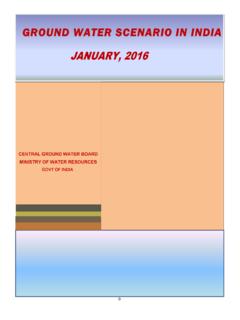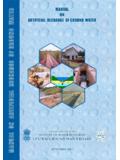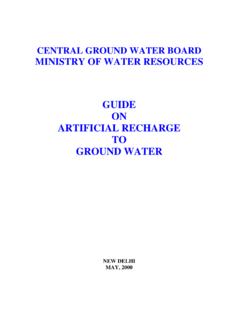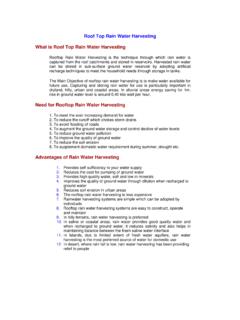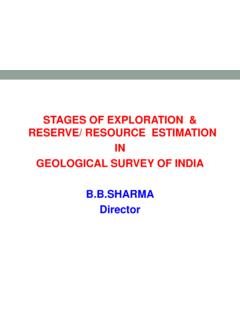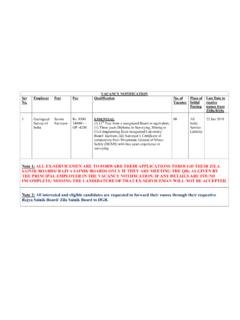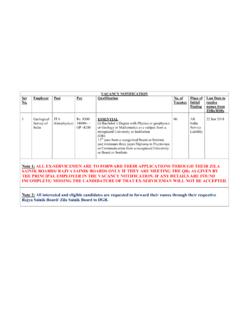Transcription of GOVERNMENT OF INDIA MINISTRY OF WATER …
1 GOVERNMENT OF INDIA MINISTRY OF WATER RESOURCES CENTRAL GROUND WATER BOARD Western Region Jaipur 2013 DISTRICT GROUNDWATER BROCHURE DISTRICT AT A GLANCE jodhpur DISTRICT, RAJASTHAN S No Item Information GENERAL INFORMATION (i) Geographical area (sq km) 22,850 (ii) Administrative Division (As on ) Number of Tehsils 07 Number of Blocks 09 Number of Villages 1157 (iii) Population (As per 2011 Census) 3687165 1 (iv) Average Annual Rainfall (1969-2012) 374 mm GEOMORPHOLOGY Major Physiographic Units Sand Dunes, Alluvial plains, Ridges and Hillocks 2 Major Drainage Luni River & Mithri River LAND USE (ha) (2010-11) (Source: Dte. of Economics & Statistics, MINISTRY of Agriculture, GOI (a) Forest Area 6996 (b) Net Sown Area 1371703 3 (c) Total Cropped Area 1580126 4 MAJOR SOIL TYPE Red desertic soils, Desert soils, Sand dunes, Lithosols & Regosols of hills, Saline soils and Sierozems.)
2 Crops Area in hactare. Bajra 635173 Wheat 59285 Jowar 57240 Pulses 296352 Onion 17236 Ground nut 49084 Castor 25682 Sesamum 29577 Chilli 10,000 Rapeseed & Mustard 78487 5 AREA UNDER PRINCIPAL CROPS (AS ON 2010-11) (Source: Dte. of Economics & Statistics, MINISTRY of Agriculture, GOI) Cotton 11611 IRRIGATION BY DIFFERENT SOURCES (As on 2010-11) (Source: Dtge. Of Economics & Statistics, MINISTRY of Agriculture, GOI) Source Net Irrigated Area (ha) Gross Irrigated Area (ha) Tubewells 260535 401315 Other wells 4884 5592 Other Sources 262 262 Net Irrigated Area (ha) 265681 6 Gross Irrigated Area (ha) 407169 NUMBER OF GROUND WATER MONITORING WELLS OF CGWB(As on May 2011) 7 Number of Dug wells 61 ii S No Item Information Number of Piezometers 32 8 PREDOMINANT geological FORMATIONS Quaternary aeolian sand, Alluvium, Bap Boulder Bed, Nagaur Sandstone, Bilara Limestone and jodhpur Sandstone of Marwar Super Group, Malani Igneous Suite, Erinpura granite & rocks of Delhi Super Group.
3 HYDROGEOLOGY Major WATER bearing formation Quaternary alluvium, Nagaur Sandstone, Bilara Limestone and jodhpur Sand -stone, Rhyolite, Granite, Schist and Phyllite. Depth to WATER level (Pre-monsoon, 2011) (mbgl) to 9 Depth to WATER level (Post-monsoon, 2011) (mbgl) to GROUNDWATER EXPLORATION BY CGWB (As on ) Number of wells drilled (EW, OW, PZ, SH) EW 52,OW- 12, SH 17 & PZ- 18 Depth Range (m) 21 Discharge (litre per second) Negligible 75 Storativity - 10 Transmissivity (m2/day) Up to 832 m2/day in alluvium GROUND WATER QUALITY 11 Presence of chemical constituents more than permissible limit (EC>1500 m mhos/ cm at 250 C, F> mg/l, NO3> 45mg/l) EC 4500 sq km F 6500 sq km NO3 3000 sq km 12 DYNAMIC GROUND WATER RESOURCES (March, 2009) in mcm Annual Replenishable Ground WATER Resource Net Annual Ground WATER Draft Stage of Ground WATER Development 13 MAJOR GROUND WATER PROBLEMS AND ISSUES 1.
4 WATER level decline. 2. Rising WATER level in jodhpur city. 3. Quality Problem. 4. Industrial pollution. 5. Less groundwater recharge due to scanty & uneven rainfall. 14 MASS AWARENESS AND TRAINING PROGRAMMES CONDUCTED BY CGWB Mass Awareness Program Bilara, Mandore Training Program Mathania, Mandore 15 AREAS NOTIFIED BY CGWA Bilara, Bhopalgarh, Mandore, Osian Ground WATER Information jodhpur District Contents Rainfall & Geomorphology & Soil, Land Use & Irrigation Land-Use Pattern .. 4 Crops .. 5 5 Ground WATER Scenario ..5 geological Framework .. 5 5 Depth to WATER 8 WATER Level Fluctuations .. 9 Ground WATER Quality .. 11 Ground WATER Resources ..13 Status Of Ground WATER Development ..14 Ground WATER Management Ground WATER 14 WATER Conservation and Artificial 15 Awareness & Training Activity .. 15 Areas notified by CGWA .. 15 Ground WATER Related Issues & List of Figures 1.
5 Map showing Administrative Divisions 2. Hydrogeology 3. Depth to WATER Level Pre-monsoon (May 2011) 4. Depth to WATER Level - Post- monsoon (Nov. 2011) 5. Seasonal fluctuations during 2011 (pre and post) 6. Decadal Pre-monsoon WATER Level Trend (May, 2002 May, 2011) 7. Iso Electrical Conductivity (May 2011) 8. Iso Fluoride Map (May 2011) 9. Distribution of Nitrate (May 2011) 10. Iso-Iron (May 2011) List of Tables 1. Scientific studies undertaken by CGWB 2. Salient features of ground WATER exploration 3. Geomorphic units 4. Landuse pattern 5. Source wise area irrigated 6. Block wise replenishable ground WATER resources 1 DISTRICT GROUND WATER BROCHURE jodhpur DISTRICT Introduction jodhpur district is situated between 25051 08 & 27037 09 North latitude and 71048 09 & 73052 06 East longitude covering geographical area of 22,850 sq km. This district comes under arid zone of the Rajasthan State.
6 jodhpur district is part of jodhpur Division. The district is divided into 5 sub-divisions namely jodhpur , Shergarh, Pipar City, Osian & Phalodi and comprises of 07 tehsils & 09 blocks. Total number of villages in the district is 1157. jodhpur district is bounded by Nagaur in the East, Jaisalmer in the West, Bikaner in the North and Barmer as well as Pali in the South. Population of the district is 3687165 including rural and urban populace of 2422551 and 1264614 respectively. Decadal population growth rate of the district is since 2001. The district is known for its Guar gum industries and mineral wealth. Map showing administrative divisions of jodhpur district is presented in Fig. 1. Fig. 1: Administrative Divisions 2 Systematic hydrogeological survey in parts of jodhpur district was initially carried out by Kidwai (1963-64), Sangre (1965-66), Khan (1968-70), Karanth and Siddiqui (1970), Siddiqui (1970) of geological survey of INDIA .
7 Ground WATER survey of Borunda area was carried out under UNDP Project (Phase I) during 1967 71. Central Ground WATER Board has taken up various scientific studies in the district since its inception in 1972. A list of studies carried out in the district is given in Table 1. Table 1: Studies undertaken by CGWB. S. No. Officer AAP Type of survey /Study 1. V. Sharma 1975-76 Systematic hydrogeological investigations covering parts of Ajmer, jodhpur , Nagaur and Pali districts 2. Verma 1978-79 Reappraisal hydrogeological study of ground WATER resources in Mathania area, district jodhpur . 3. S. Kumar 1983-84 Reappraisal hydrogeological investigation in Doli Jhanwar Pal area, district jodhpur 4. Sharma 1986-87 Reappraisal survey in Osian block, jodhpur district 5. A. Dewan, Rama Kishan and Gupta 1988-89 Reappraisal hydrogeological survey in parts of Nagaur and jodhpur districts 6.
8 Rama Kishan 1992-93 Reappraisal hydrogeological survey in Luni and Bilara blocks of jodhpur district 7. Srivastava 1993-94 Reappraisal hydrogeological survey in drought prone area of Mandore and Balesar blocks 8. Sharma 1993-94 Reappraisal hydrogeological survey in drought prone area of Phalodi block 9. Sharma 1994-95 Reappraisal hydrogeological survey in Bap block of jodhpur district 10. Srivastava 1994-95 Reappraisal Hydrogeological survey in Shergarh block of jodhpur district The report on Ground WATER Resources and Development Prospects in jodhpur district was brought out by Central Ground WATER Board in the year 1988. Revised report was issued in 2005. Exploratory drilling in jodhpur district was first carried out by the erstwhile Exploratory Tubewells Organization during 1956-57. Detailed exploration was carried out in certain selected patches under UNDP Project (Phase I) implemented during 1967-71.
9 Central Ground WATER Board has drilled so far drilled 68 Exploratory wells, 7 Observation wells, 38 piezometers and 12 slim holes in the district. Salient features of ground WATER exploration are listed in Table 2. Central Ground WATER Board also monitors ground WATER levels through a network of 93 observation wells four times in a year during the months of January, May, August and November. Samples for WATER quality analyses are collected during May. Table 2: Salient Features of Ground WATER Exploration Type of well No. Depth drilled (m) SWL (m) T (m2/day) Discharge (lpm) EC (micromhos/cm) at 25oC EW 68 373 832 4 4542 520 -31370 OW 7 87. 3 8 1420 780 -4000 PZ 3 21 - 144 - 900 505 22360 SH 7 - 153 587 15512 3 Rainfall & Climate The district experiences arid to semi-arid type of climate. Mean annual rainfall (1971-2012) of the district is 374 mm whereas normal rainfall (1901-1970) is lower than average rainfall and is placed at 314 mm.
10 Rainy days are limited to maximum 15 in a year. Almost 80% of the total annual rainfall is received during the southwest monsoon, which enters the district in the first week of July and withdraws in the mid of September. Probability of annual rainfall exceeding 650 mm is only 10%. However, there is 90% probability that the annual rainfall will be more than 190 mm. The probability of occurrence of mean annual rainfall is 45%. Drought analysis based on agriculture criteria indicates that the district is prone to mild and normal type of droughts. Occurrence of severe and very severe type of drought is very rare. As the district lies in the desert area, extremes of heat in summer and cold in winter are the characteristic of the desert. Both day and night temperatures increase gradually and reach their maximum in May and June respectively. The temperature varies from 49oC in summer to 1oC in winter.



